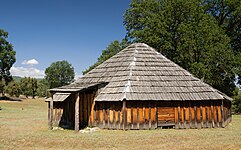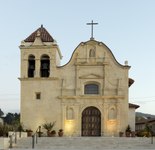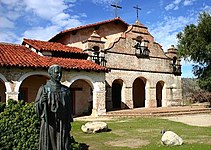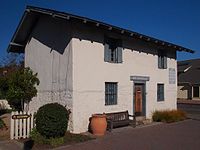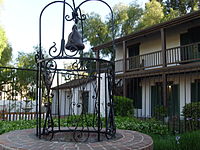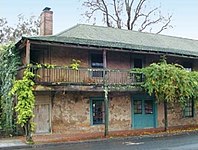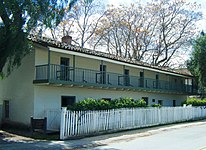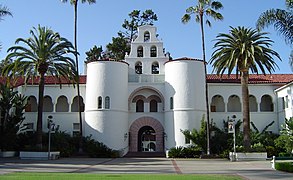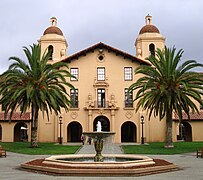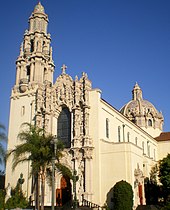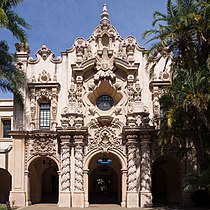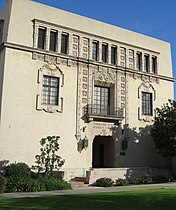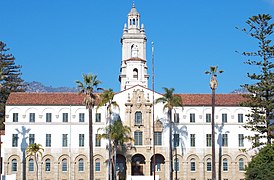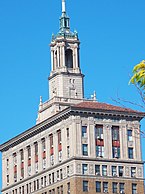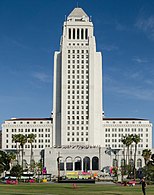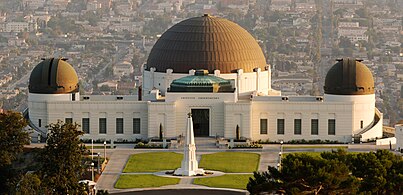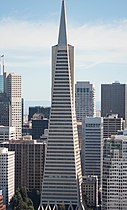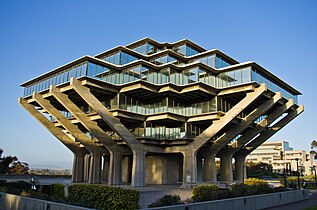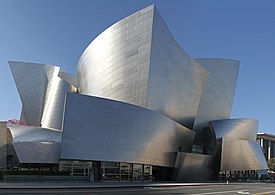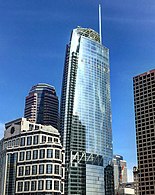The architecture of California reflects the diverse history of California through a broad variety of architectural styles and built forms. Architecture, like other aspects of Californian culture, has been heavily influenced by California's Hispanic heritage, from the periods of Spanish California and Mexican California, as well as the larger trends of American architecture, since the Conquest of California.
Various vernacular styles have developed in California over time, influenced by the diverse peoples that built them. The architecture of the California missions, largely built from 1769 to 1833, has plaid an influential role in both civic and vernacular architectural styles across California, largely via Mission Revival and Spanish Colonial Revival architecture. Following the 1915 Panama–California Exposition, the California Churrigueresque revival style became particularly influential in religious and civic architecture.
In the 20th century, California was heavily marked by the prominence of its own modernist styles, such as Art Deco architecture and Mid-Century Modern. Contemporary Californian architecture is broad in its forms and styles, encompassing movements such as Deconstructivism, Expressionism, and Sustainable architecture. Notable California-based architects include Frank Gehry, Thom Mayne, Richard Meier, Joseph Eichler, Julia Morgan, George Washington Smith, Paul Williams, and Bertram Goodhue.
History
Indigenous Californians
The historical building techniques and architectural styles of the indigenous peoples of the Californias, who have lived in California for over 19,000 years, varied by region, ethnic group, and time period. The subjugation of indigenous peoples in the Spanish missions of Caifornia largely stripped most indigenous communities of their traditional practices, including building practices. Within several generations of the large relocation of indigenous populations to Spanish missions, most indigenous building techniques were largely abandoned, with the integration of indigenous peoples into larger Californian society.
The Yurok of Northern California traditionally built large Plank houses, usually out of Redwood or Cedar. [1]
The Plains and Sierra Miwok traditionally built large rounded houses made of brush and mud, as well as umuucha, rounded bark huts. [2]
The Tongva of Southern California traditionally built willow houses, known as kiiy, which were located at the center of village sites, surrounded by accessory campsites and huts. [3]
- Examples of pre-colonial architecture of Indigenous Californians
-
A Gabrieleño Tongva willow house.
-
Tongva ceremonial house.
-
Maidu reed hut.
-
Chemehuevi adobe house.
Spanish colonial architecture
Through much of the Spanish period, the majority of California's cities and settlements lacked consistent masonry resources, meaning that the majority of construction was done using adobe (a type of mudbrick), alongside local woods, especially Redwoods and California oak. [4] The majority of building materials used during this time originated in the area of the construction site, resulting in a variety of adobe types across California, varying according to the geology and climate of the area. [4] The simplicity or complexity of adobe constructions depended on the social and economic status of the constructor, as well as whether they were located within pueblos (towns) or on a rancho (rural land grant). [4] Notable examples of residential architecture from this period include the Casa de la Guerra, in Santa Barbara, and the Diego Sepúlveda Adobe, in Costa Mesa. [5]
Spanish colonial architecture is divided into three principal historic groupings: military architecture, civilian architecture, and the California Missions. During this time, the development of California's settlements, religious, civilian, or military, was led by military engineers of the Spanish Army, as the majority of California's Spanish population was divided between soldiers, serving at military bases, and retired soldiers, populating the pueblos and ranchos of California. [6] The Spanish Empire divided Alta California into the four military districts of California, each administered from a presidio. Presidios were built in a square shape, centered upon a plaza de armas, a military staging ground. Of the four presidios established, the Presidio of Santa Barbara has the only surviving original military structures while the Presidio of Monterey has the only surviving presidio chapel (as well as the being the only presidio that continues in active military use to this day). [7]
The Spanish founded three pueblos, civilian towns that were not attached to a mission or a presidio: San José (1777), Los Angeles (1781), and Branciforte (1797), the last of which eventually merged into Santa Cruz. Pueblos were laid out surrounding a central plaza. Today, the Plaza de César Chávez, in SJ, and the Plaza de Los Ángeles, in LA, are the only town plazas that remain from the Spanish period. [8] [9] El Molino Viejo in San Marino is of the few surviving examples of commercial buildings from the Spanish period. [10]
While most religious architecture from this period concerns the Spanish missions in California, both pueblos and presidios always constructed church buildings to serve the soldiers and settlers. The only surviving presidio chapel now serves as Monterey's Cathedral of San Carlos Borromeo. [11] The only surviving pueblo church is Nuestra Señora la Reina de los Ángeles Church in Los Angeles. [12]
- Examples of the Spanish colonial architecture
California Missions
The architecture of the California Missions was influenced by several marking factors, including limitations in construction materials and skilled labor in the then-sparsely populated Las Californias, a province of the Viceroyalty of New Spain. The missions were built by the Spanish between 1769 and 1817, under the auspices of the Franciscan Order ( Mission San Francisco Solano is the only mission built under Mexican rule, from 1823-1833). They formed the backbone of Spanish colonization in Alta California, serving as religious, economic, and urban centers in Spanish California. The oldest cities of California formed around the missions, including the four largest: Los Angeles, San Diego, San José, and San Francisco.
While the architecture of individual missions varies greatly, owing to time period and proximity to economic or population centers, all of the missions of Alta California share the following in common: arcades, pedimented gables; bell towers, low-sloped mission tile roofs. [13] The quality of the tiles, both in color and durability, vary greatly among the missions due to differences in soil types from one site to another. Popular legend has it that the first tiles were made at Mission San Luis Obispo, but Franciscan padre Maynard Geiger claims that Mission San Antonio de Padua was more likely to have been the first to use them. [14] Decorative elements were usually copied from books on architecture and art from Mexico and Spain. Much of the decoration of the California Missions was done by Indigenous Californian artists, which resulted in a unique adaptation of designs from Mexico and Spain with local, indigenous motifs. [15]
The impact that the California Missions have had on the architectural history of California is readily apparent in the many civic, commercial, religious, and residential structures built across the state in various times which exhibit the typifying features of the missions, especially red mission tiles, Saltillo tiles, long arched arcades, and white stuccoed exterior, which form the basis of the Mission Revival Style.
- Examples of the California Missions
Mexican era architecture
In the period of Mexican California, construction was notably characterized by the proliferation of civic and commercial architecture in the pueblos and ranchos of California. After the Mexican Congress of the Union passed the the 1833 Decree for the Secularization of the Missions of California, lands belonging to the Californian mission system were broken up and granted to Californio rancheros and vaqueros. Between 1833 and 1846, the governors of Alta California granted over 270 rancho grants, totaling hundreds of thousands of acres across California.
- Examples of the Mexican colonial architecture
Monterey Colonial
- Examples of the Monterey Colonial architecture
Mission Revival
- Examples of the Mission Revival architecture
California Churrigueresque
California Churrigueresque is a Spanish Colonial revival style of the Churrigueresque style of Late Mexican Baroque architecture, which flourished in the Viceroyalty of New Spain largely from 1730-1781. [16] The revival style was developed from 1910–1914 for use in the Panama–California Exposition in San Diego, by architects Bertram Goodhue and Carleton Winslow, who sought to create a monumental regional Californian architecture based in California's Hispanic heritage. [17] [18] Following the success of the style at the Panama-California Exposition, California Churrigueresque rapidly became the dominant regional architectural style, particularly used in monuments, churches, civic buildings, theatres, and schools. [18] [19] [20] [21]
The development of California Churrigueresque is intimately linked with the dissatisfaction Goodhue had with Mission Revival architecture, which was originally conceived as the logical style to build in for the Panama-California Exposition, being California's most prominent regional style at the time. Though Goodhue found Mission Revival architecture to be a charming style, he considered it to be too limited and ill-adaptable for the construction of buildings deserving monumentality, as it was based on the 18th century California Missions, many of which were built in rudimentary forms and with unsophisticated design. [22] [23] Instead, Goodhue and Winslow wished to create a grand, imposing form of regional Californian architecture and sought their inspiration in travels throughout Mexico studying Late Mexican Baroque architecture, particularly drawing on the architecture of the Cathedral Basilica of Zacatecas in Zacatecas City, the Balvanera Chapel at San Francisco Convent in Mexico City, and the Tabernacle of the Mexico City Metropolitan Cathedral. [24] Key features of California Churrigueresque include highly ornamentalized, multi-tier portals, use of Solomonic columns and estipites, as well as motifs evoking aspects of Pre-Columbian art and Mexican folk art. [25]
Notable architects of the style include Timothy L. Pflueger, Stiles O. Clements, John W. Reid Jr., Albert C. Martin Sr., Walker & Eisen, Harry G. Koerner, W. H. Weeks, William J. Gage, and Myron Hunt. [26] Prominent examples of California Churrigueresque architecture include the El Prado Complex in San Diego's Balboa Park (namely the California Tower, House of Charm, the Plaza de Panama, the House of Hospitality, the Casa del Prado, and the Casa de Balboa), San Francisco's Mission Dolores Basilica and Mission High School, Novato's Marin Museum of Contemporary Art, Hollywood's El Capitan Theatre, Los Angeles's Million Dollar Theater and Golden Gate Theater, the First Congregational Church of Riverside, Santa Ana's Santora Building, Pasadena's Howard Motor Company Building, San Francisco's Castro Theatre, the Beverly Hills City Hall, Los Angeles's St. Vincent de Paul Church, the Glendale Transportation Center, the Campus of the California Institute of Technology in Pasadena, Woodland's Hotel Woodland, San Mateo's Draper University, and Los Angeles's Chapman Plaza and the Portal of the Folded Wings Shrine to Aviation. [27] [28]
- Examples of California Churrigueresque architecture
Spanish Eclecticism
- Examples of the Spanish Eclectic architecture
Beaux-Arts architecture
- Examples of Californian Beaux-Arts architecture
Art Deco architecture
- Examples of Californian Art Deco architecture
Modern architecture
- Examples of Californian Modernist architecture
Contemporary architecture
Contemporary architecture in California is highly diverse in form and styles. Various movements including Deconstructivism, Expressionist architecture, Sustainable architecture, high-tech architecture, and Neo-futurism have all been practiced to varying polarities in both northern and southern California.
Walt Disney Concert Hall in Los Angeles, designed by Pritzker Prize-winning architect Frank Gehry, is a world-famed example of Deconstructivist architecture. Apple Park in Cupertino, designed by Pritzker Prize-winning architect Norman Foster, is a prominent example of neo-futurist architecture. The Sundial Bridge in Redding, designed by Spanish architect Santiago Calatrava, is a well-known example of a cantilever spar cable-stayed bridge. Noted Pritzker-winning abstract architect Richard Meier designed both San José City Hall and LA's Getty Center. The California Academy of Sciences, an award-winning example of sustainable architecture in San Francisco, was designed by Pritzker-winning Italian architect Renzo Piano in 2008. Los Angeles's Wilshire Grand Center, completed in 2017 and designed by David C. Martin, is the tallest building in the Western United States.
- Examples of Contemporary Californian architecture
See also
References
- ^ "Cedar: Tree of Life to the Northwest Coast Indians," by Hilary Stewart describes and illustrates the harvesting of individual planks from living trees.
- ^ Craig D. Bates Museum Anthropology 17(2):13 (June 1993)
-
^ Chester King (1987).
"Ethnohistoric Reconstruction of Subsistence-Settlement Systems in the Vicinity of Burton Mesa": 10. Retrieved 7 July 2019.
{{ cite journal}}: Cite journal requires|journal=( help) - ^ a b c Diana Leigh Daymond. "Residential California Adobe: Mud Form". Massachusetts Institute of Technology. hdl: 1721.1/35331. Retrieved 16 May 2020.
- ^ "Casa de la Guerra". Office of Historic Preservation, California State Parks. Retrieved 2012-10-14.
- ^ Iris H. Engstrand (1985). "California Ranchos: Their Hispanic Heritage". Southern California Quarterly. 67 (3): 281–290. doi: 10.2307/41171160. JSTOR 41171160. Retrieved 16 May 2020.
- ^ Randy Leffingwell. "California Missions & Presidios". Voyager Press. JSTOR 41171160. Retrieved 16 May 2020.
- ^ Historical Society of Southern California; Pioneer Register, Los Angeles (1898). Annual Publication of the Historical Society of Southern California and Pioneer Register, Los Angeles (Public domain ed.). The Society. pp. 247–.
- ^ Carlson, Eric (1999). "Plaza de Cesar E. Chavez". Soft Underbelly of San Jose. Boulevards. Retrieved May 7, 2019.
- ^ "California Art Club". Traditional Fine Arts Organization, Inc. Archived from the original on 2008-05-15.
- ^ National Historic Landmark Summary by the National Park Service Archived October 8, 2012, at the Wayback Machine
-
^ Los Angeles Department of City Planning (September 7, 2007).
"Historic - Cultural Monuments (HCM) Listing: City Declared Monuments" (PDF) (Document). City of Los Angeles.
{{ cite document}}: Cite has empty unknown parameter:|edition=( help); Unknown parameter|accessdate=ignored ( help) - ^ Newcomb, p. ix
- ^ Crump, p. 17
- ^ Baer, p. 50
- ^ "Historia del Arte y Arquitectura Mexicana" (PDF). Universidad Autónoma del Estado de Hidalgo. Retrieved 27 September 2019.
- ^ Christman (1985), p. 41
- ^ a b Montes, Gregory (Winter 1982). "Balboa Park, 1909–1911 The Rise and Fall of the Olmsted Plan". The Journal of San Diego History. 28 (1). Archived from the original on July 19, 2011.
- ^ "Cultural Resources of the City of San José" (PDF). City of San José. Retrieved 25 September 2019.
- ^ Dinkelspiel Cerny, Susan (2007). An Architectural Guidebook to San Francisco and the Bay Area. Gibbs Smith. p. 209. ISBN 978-1586854324.
- ^ Marian Lestrange. "Church Architecture of Four Denominations in Los Angeles" (PDF). California State University, Northridge. Retrieved 27 September 2019.
- ^ David Gebhard. "The Spanish Colonial Revival in Southern California (1895-1930)" (PDF). University of California, Santa Barbara. Retrieved 27 September 2019.
- ^ Richard W. Amero. "The Making of the Panama-California Exposition, 1909-1915" (PDF). Journal of San Diego History. Retrieved 27 September 2019.
- ^ Richard W. Amero. "The California Building, A Case of Misunderstood Baroque" (PDF). Balboa Park. Retrieved 27 September 2019.
- ^ de la Maza, Francisco (1969). El Churrigueresco en la Ciudad de México. México: Fondo de Cultura Económica. ISBN 9789681620424.
- ^ "PCAD - San Francisco Unified School District (SFUSD), Mission High School #2, San Francisco, CA". pcad.lib.washington.edu. Retrieved 2018-10-25.
- ^ SF Planning Department
- ^ LA Curbed - Beverly Hills Landmarking 1932 Churrigueresque City Hall
- Bibliography
- Stewart, Hillary (1984). Cedar: Tree of Life to the Northwest Coast Indians. Seattle: University of Washington Press.
- Newcomb, Rexford (1973). The Franciscan Mission Architecture of Alta California. Dover Publications, Inc., New York, NY. ISBN 0-486-21740-X.
- Christman, Florence (1985). The Romance of Balboa Park (4th ed.). San Diego: San Diego Historical Society. ISBN 0-918740-03-7.
External links
Further Reading
- https://books.google.pt/books?id=rPcwuEe9MBQC&pg=PA382&lpg=PA382&dq=%22mexican+architecture%22+%22california%22&source=bl&ots=oiibd-1Sza&sig=ACfU3U2avGCtwSwoqL1jCqBoXAf2SiSNPQ&hl=en&sa=X&ved=2ahUKEwi6rbG02OrkAhVC5uAKHRzNCdUQ6AEwFHoECAkQAQ#v=onepage&q=%22mexican%20architecture%22%20%22california%22&f=false
- https://www.sandiegoreader.com/news/2000/may/25/cover-mexican-landscapes-san-diego/#
- https://www.latimes.com/entertainment/arts/miranda/la-et-cam-colonial-california-design-lacma-20180329-story.html
- https://scholar.google.com/scholar?start=20&q=%22californian+architecture%22&hl=en&as_sdt=0,5
- https://scholar.google.com/scholar?start=0&q=%22california%22+%22churrigueresque%22&hl=en&as_sdt=0,5
- http://calteches.library.caltech.edu/3982/1/Chemistry.pdf
- https://c100.org/books/articles/Gebhard_Spanish.Colonial.Arch.pdf
- https://books.google.pt/books?hl=en&lr=&id=gDSOF9-rsC4C&oi=fnd&pg=PR5&dq=%22architecture+of+california%22&ots=2IW4enOtL4&sig=x4M_dyVC_sUyeElmwfzMEr_vbII&redir_esc=y#v=onepage&q&f=false
- https://www.jstor.org/stable/25157399?seq=1#page_scan_tab_contents
- https://www.jstor.org/stable/25463690?seq=1#page_scan_tab_contents
- https://www.jstor.org/stable/25155953?seq=1#page_scan_tab_contents
- https://jsah.ucpress.edu/content/46/2/157.abstract
- https://jsah.ucpress.edu/content/46/2/157.abstract
- https://www.cambridge.org/core/journals/architectural-history/article/richard-neutras-search-for-the-southland-california-latin-america-and-spain/4F6845C41615F5EF98894912A7C48E36
- https://www.jstor.org/stable/41171275?seq=1#page_scan_tab_contents
- https://jsah.ucpress.edu/content/72/1/100.abstract
- https://books.google.pt/books?hl=en&lr=&id=WVw2AQAAQBAJ&oi=fnd&pg=PR13&dq=%22californian+architecture%22&ots=WAEmIEoDqU&sig=QyaJXixgRNhOeKR59h8bKWk3YUc&redir_esc=y#v=onepage&q&f=false
- http://csusm-dspace.calstate.edu/handle/10211.3/139189
[[Category:Architecture in California] [[Category:Culture of California] [[Category:Architecture of the United States]
The architecture of California reflects the diverse history of California through a broad variety of architectural styles and built forms. Architecture, like other aspects of Californian culture, has been heavily influenced by California's Hispanic heritage, from the periods of Spanish California and Mexican California, as well as the larger trends of American architecture, since the Conquest of California.
Various vernacular styles have developed in California over time, influenced by the diverse peoples that built them. The architecture of the California missions, largely built from 1769 to 1833, has plaid an influential role in both civic and vernacular architectural styles across California, largely via Mission Revival and Spanish Colonial Revival architecture. Following the 1915 Panama–California Exposition, the California Churrigueresque revival style became particularly influential in religious and civic architecture.
In the 20th century, California was heavily marked by the prominence of its own modernist styles, such as Art Deco architecture and Mid-Century Modern. Contemporary Californian architecture is broad in its forms and styles, encompassing movements such as Deconstructivism, Expressionism, and Sustainable architecture. Notable California-based architects include Frank Gehry, Thom Mayne, Richard Meier, Joseph Eichler, Julia Morgan, George Washington Smith, Paul Williams, and Bertram Goodhue.
History
Indigenous Californians
The historical building techniques and architectural styles of the indigenous peoples of the Californias, who have lived in California for over 19,000 years, varied by region, ethnic group, and time period. The subjugation of indigenous peoples in the Spanish missions of Caifornia largely stripped most indigenous communities of their traditional practices, including building practices. Within several generations of the large relocation of indigenous populations to Spanish missions, most indigenous building techniques were largely abandoned, with the integration of indigenous peoples into larger Californian society.
The Yurok of Northern California traditionally built large Plank houses, usually out of Redwood or Cedar. [1]
The Plains and Sierra Miwok traditionally built large rounded houses made of brush and mud, as well as umuucha, rounded bark huts. [2]
The Tongva of Southern California traditionally built willow houses, known as kiiy, which were located at the center of village sites, surrounded by accessory campsites and huts. [3]
- Examples of pre-colonial architecture of Indigenous Californians
-
A Gabrieleño Tongva willow house.
-
Tongva ceremonial house.
-
Maidu reed hut.
-
Chemehuevi adobe house.
Spanish colonial architecture
Through much of the Spanish period, the majority of California's cities and settlements lacked consistent masonry resources, meaning that the majority of construction was done using adobe (a type of mudbrick), alongside local woods, especially Redwoods and California oak. [4] The majority of building materials used during this time originated in the area of the construction site, resulting in a variety of adobe types across California, varying according to the geology and climate of the area. [4] The simplicity or complexity of adobe constructions depended on the social and economic status of the constructor, as well as whether they were located within pueblos (towns) or on a rancho (rural land grant). [4] Notable examples of residential architecture from this period include the Casa de la Guerra, in Santa Barbara, and the Diego Sepúlveda Adobe, in Costa Mesa. [5]
Spanish colonial architecture is divided into three principal historic groupings: military architecture, civilian architecture, and the California Missions. During this time, the development of California's settlements, religious, civilian, or military, was led by military engineers of the Spanish Army, as the majority of California's Spanish population was divided between soldiers, serving at military bases, and retired soldiers, populating the pueblos and ranchos of California. [6] The Spanish Empire divided Alta California into the four military districts of California, each administered from a presidio. Presidios were built in a square shape, centered upon a plaza de armas, a military staging ground. Of the four presidios established, the Presidio of Santa Barbara has the only surviving original military structures while the Presidio of Monterey has the only surviving presidio chapel (as well as the being the only presidio that continues in active military use to this day). [7]
The Spanish founded three pueblos, civilian towns that were not attached to a mission or a presidio: San José (1777), Los Angeles (1781), and Branciforte (1797), the last of which eventually merged into Santa Cruz. Pueblos were laid out surrounding a central plaza. Today, the Plaza de César Chávez, in SJ, and the Plaza de Los Ángeles, in LA, are the only town plazas that remain from the Spanish period. [8] [9] El Molino Viejo in San Marino is of the few surviving examples of commercial buildings from the Spanish period. [10]
While most religious architecture from this period concerns the Spanish missions in California, both pueblos and presidios always constructed church buildings to serve the soldiers and settlers. The only surviving presidio chapel now serves as Monterey's Cathedral of San Carlos Borromeo. [11] The only surviving pueblo church is Nuestra Señora la Reina de los Ángeles Church in Los Angeles. [12]
- Examples of the Spanish colonial architecture
California Missions
The architecture of the California Missions was influenced by several marking factors, including limitations in construction materials and skilled labor in the then-sparsely populated Las Californias, a province of the Viceroyalty of New Spain. The missions were built by the Spanish between 1769 and 1817, under the auspices of the Franciscan Order ( Mission San Francisco Solano is the only mission built under Mexican rule, from 1823-1833). They formed the backbone of Spanish colonization in Alta California, serving as religious, economic, and urban centers in Spanish California. The oldest cities of California formed around the missions, including the four largest: Los Angeles, San Diego, San José, and San Francisco.
While the architecture of individual missions varies greatly, owing to time period and proximity to economic or population centers, all of the missions of Alta California share the following in common: arcades, pedimented gables; bell towers, low-sloped mission tile roofs. [13] The quality of the tiles, both in color and durability, vary greatly among the missions due to differences in soil types from one site to another. Popular legend has it that the first tiles were made at Mission San Luis Obispo, but Franciscan padre Maynard Geiger claims that Mission San Antonio de Padua was more likely to have been the first to use them. [14] Decorative elements were usually copied from books on architecture and art from Mexico and Spain. Much of the decoration of the California Missions was done by Indigenous Californian artists, which resulted in a unique adaptation of designs from Mexico and Spain with local, indigenous motifs. [15]
The impact that the California Missions have had on the architectural history of California is readily apparent in the many civic, commercial, religious, and residential structures built across the state in various times which exhibit the typifying features of the missions, especially red mission tiles, Saltillo tiles, long arched arcades, and white stuccoed exterior, which form the basis of the Mission Revival Style.
- Examples of the California Missions
Mexican era architecture
In the period of Mexican California, construction was notably characterized by the proliferation of civic and commercial architecture in the pueblos and ranchos of California. After the Mexican Congress of the Union passed the the 1833 Decree for the Secularization of the Missions of California, lands belonging to the Californian mission system were broken up and granted to Californio rancheros and vaqueros. Between 1833 and 1846, the governors of Alta California granted over 270 rancho grants, totaling hundreds of thousands of acres across California.
- Examples of the Mexican colonial architecture
Monterey Colonial
- Examples of the Monterey Colonial architecture
Mission Revival
- Examples of the Mission Revival architecture
California Churrigueresque
California Churrigueresque is a Spanish Colonial revival style of the Churrigueresque style of Late Mexican Baroque architecture, which flourished in the Viceroyalty of New Spain largely from 1730-1781. [16] The revival style was developed from 1910–1914 for use in the Panama–California Exposition in San Diego, by architects Bertram Goodhue and Carleton Winslow, who sought to create a monumental regional Californian architecture based in California's Hispanic heritage. [17] [18] Following the success of the style at the Panama-California Exposition, California Churrigueresque rapidly became the dominant regional architectural style, particularly used in monuments, churches, civic buildings, theatres, and schools. [18] [19] [20] [21]
The development of California Churrigueresque is intimately linked with the dissatisfaction Goodhue had with Mission Revival architecture, which was originally conceived as the logical style to build in for the Panama-California Exposition, being California's most prominent regional style at the time. Though Goodhue found Mission Revival architecture to be a charming style, he considered it to be too limited and ill-adaptable for the construction of buildings deserving monumentality, as it was based on the 18th century California Missions, many of which were built in rudimentary forms and with unsophisticated design. [22] [23] Instead, Goodhue and Winslow wished to create a grand, imposing form of regional Californian architecture and sought their inspiration in travels throughout Mexico studying Late Mexican Baroque architecture, particularly drawing on the architecture of the Cathedral Basilica of Zacatecas in Zacatecas City, the Balvanera Chapel at San Francisco Convent in Mexico City, and the Tabernacle of the Mexico City Metropolitan Cathedral. [24] Key features of California Churrigueresque include highly ornamentalized, multi-tier portals, use of Solomonic columns and estipites, as well as motifs evoking aspects of Pre-Columbian art and Mexican folk art. [25]
Notable architects of the style include Timothy L. Pflueger, Stiles O. Clements, John W. Reid Jr., Albert C. Martin Sr., Walker & Eisen, Harry G. Koerner, W. H. Weeks, William J. Gage, and Myron Hunt. [26] Prominent examples of California Churrigueresque architecture include the El Prado Complex in San Diego's Balboa Park (namely the California Tower, House of Charm, the Plaza de Panama, the House of Hospitality, the Casa del Prado, and the Casa de Balboa), San Francisco's Mission Dolores Basilica and Mission High School, Novato's Marin Museum of Contemporary Art, Hollywood's El Capitan Theatre, Los Angeles's Million Dollar Theater and Golden Gate Theater, the First Congregational Church of Riverside, Santa Ana's Santora Building, Pasadena's Howard Motor Company Building, San Francisco's Castro Theatre, the Beverly Hills City Hall, Los Angeles's St. Vincent de Paul Church, the Glendale Transportation Center, the Campus of the California Institute of Technology in Pasadena, Woodland's Hotel Woodland, San Mateo's Draper University, and Los Angeles's Chapman Plaza and the Portal of the Folded Wings Shrine to Aviation. [27] [28]
- Examples of California Churrigueresque architecture
Spanish Eclecticism
- Examples of the Spanish Eclectic architecture
Beaux-Arts architecture
- Examples of Californian Beaux-Arts architecture
Art Deco architecture
- Examples of Californian Art Deco architecture
Modern architecture
- Examples of Californian Modernist architecture
Contemporary architecture
Contemporary architecture in California is highly diverse in form and styles. Various movements including Deconstructivism, Expressionist architecture, Sustainable architecture, high-tech architecture, and Neo-futurism have all been practiced to varying polarities in both northern and southern California.
Walt Disney Concert Hall in Los Angeles, designed by Pritzker Prize-winning architect Frank Gehry, is a world-famed example of Deconstructivist architecture. Apple Park in Cupertino, designed by Pritzker Prize-winning architect Norman Foster, is a prominent example of neo-futurist architecture. The Sundial Bridge in Redding, designed by Spanish architect Santiago Calatrava, is a well-known example of a cantilever spar cable-stayed bridge. Noted Pritzker-winning abstract architect Richard Meier designed both San José City Hall and LA's Getty Center. The California Academy of Sciences, an award-winning example of sustainable architecture in San Francisco, was designed by Pritzker-winning Italian architect Renzo Piano in 2008. Los Angeles's Wilshire Grand Center, completed in 2017 and designed by David C. Martin, is the tallest building in the Western United States.
- Examples of Contemporary Californian architecture
See also
References
- ^ "Cedar: Tree of Life to the Northwest Coast Indians," by Hilary Stewart describes and illustrates the harvesting of individual planks from living trees.
- ^ Craig D. Bates Museum Anthropology 17(2):13 (June 1993)
-
^ Chester King (1987).
"Ethnohistoric Reconstruction of Subsistence-Settlement Systems in the Vicinity of Burton Mesa": 10. Retrieved 7 July 2019.
{{ cite journal}}: Cite journal requires|journal=( help) - ^ a b c Diana Leigh Daymond. "Residential California Adobe: Mud Form". Massachusetts Institute of Technology. hdl: 1721.1/35331. Retrieved 16 May 2020.
- ^ "Casa de la Guerra". Office of Historic Preservation, California State Parks. Retrieved 2012-10-14.
- ^ Iris H. Engstrand (1985). "California Ranchos: Their Hispanic Heritage". Southern California Quarterly. 67 (3): 281–290. doi: 10.2307/41171160. JSTOR 41171160. Retrieved 16 May 2020.
- ^ Randy Leffingwell. "California Missions & Presidios". Voyager Press. JSTOR 41171160. Retrieved 16 May 2020.
- ^ Historical Society of Southern California; Pioneer Register, Los Angeles (1898). Annual Publication of the Historical Society of Southern California and Pioneer Register, Los Angeles (Public domain ed.). The Society. pp. 247–.
- ^ Carlson, Eric (1999). "Plaza de Cesar E. Chavez". Soft Underbelly of San Jose. Boulevards. Retrieved May 7, 2019.
- ^ "California Art Club". Traditional Fine Arts Organization, Inc. Archived from the original on 2008-05-15.
- ^ National Historic Landmark Summary by the National Park Service Archived October 8, 2012, at the Wayback Machine
-
^ Los Angeles Department of City Planning (September 7, 2007).
"Historic - Cultural Monuments (HCM) Listing: City Declared Monuments" (PDF) (Document). City of Los Angeles.
{{ cite document}}: Cite has empty unknown parameter:|edition=( help); Unknown parameter|accessdate=ignored ( help) - ^ Newcomb, p. ix
- ^ Crump, p. 17
- ^ Baer, p. 50
- ^ "Historia del Arte y Arquitectura Mexicana" (PDF). Universidad Autónoma del Estado de Hidalgo. Retrieved 27 September 2019.
- ^ Christman (1985), p. 41
- ^ a b Montes, Gregory (Winter 1982). "Balboa Park, 1909–1911 The Rise and Fall of the Olmsted Plan". The Journal of San Diego History. 28 (1). Archived from the original on July 19, 2011.
- ^ "Cultural Resources of the City of San José" (PDF). City of San José. Retrieved 25 September 2019.
- ^ Dinkelspiel Cerny, Susan (2007). An Architectural Guidebook to San Francisco and the Bay Area. Gibbs Smith. p. 209. ISBN 978-1586854324.
- ^ Marian Lestrange. "Church Architecture of Four Denominations in Los Angeles" (PDF). California State University, Northridge. Retrieved 27 September 2019.
- ^ David Gebhard. "The Spanish Colonial Revival in Southern California (1895-1930)" (PDF). University of California, Santa Barbara. Retrieved 27 September 2019.
- ^ Richard W. Amero. "The Making of the Panama-California Exposition, 1909-1915" (PDF). Journal of San Diego History. Retrieved 27 September 2019.
- ^ Richard W. Amero. "The California Building, A Case of Misunderstood Baroque" (PDF). Balboa Park. Retrieved 27 September 2019.
- ^ de la Maza, Francisco (1969). El Churrigueresco en la Ciudad de México. México: Fondo de Cultura Económica. ISBN 9789681620424.
- ^ "PCAD - San Francisco Unified School District (SFUSD), Mission High School #2, San Francisco, CA". pcad.lib.washington.edu. Retrieved 2018-10-25.
- ^ SF Planning Department
- ^ LA Curbed - Beverly Hills Landmarking 1932 Churrigueresque City Hall
- Bibliography
- Stewart, Hillary (1984). Cedar: Tree of Life to the Northwest Coast Indians. Seattle: University of Washington Press.
- Newcomb, Rexford (1973). The Franciscan Mission Architecture of Alta California. Dover Publications, Inc., New York, NY. ISBN 0-486-21740-X.
- Christman, Florence (1985). The Romance of Balboa Park (4th ed.). San Diego: San Diego Historical Society. ISBN 0-918740-03-7.
External links
Further Reading
- https://books.google.pt/books?id=rPcwuEe9MBQC&pg=PA382&lpg=PA382&dq=%22mexican+architecture%22+%22california%22&source=bl&ots=oiibd-1Sza&sig=ACfU3U2avGCtwSwoqL1jCqBoXAf2SiSNPQ&hl=en&sa=X&ved=2ahUKEwi6rbG02OrkAhVC5uAKHRzNCdUQ6AEwFHoECAkQAQ#v=onepage&q=%22mexican%20architecture%22%20%22california%22&f=false
- https://www.sandiegoreader.com/news/2000/may/25/cover-mexican-landscapes-san-diego/#
- https://www.latimes.com/entertainment/arts/miranda/la-et-cam-colonial-california-design-lacma-20180329-story.html
- https://scholar.google.com/scholar?start=20&q=%22californian+architecture%22&hl=en&as_sdt=0,5
- https://scholar.google.com/scholar?start=0&q=%22california%22+%22churrigueresque%22&hl=en&as_sdt=0,5
- http://calteches.library.caltech.edu/3982/1/Chemistry.pdf
- https://c100.org/books/articles/Gebhard_Spanish.Colonial.Arch.pdf
- https://books.google.pt/books?hl=en&lr=&id=gDSOF9-rsC4C&oi=fnd&pg=PR5&dq=%22architecture+of+california%22&ots=2IW4enOtL4&sig=x4M_dyVC_sUyeElmwfzMEr_vbII&redir_esc=y#v=onepage&q&f=false
- https://www.jstor.org/stable/25157399?seq=1#page_scan_tab_contents
- https://www.jstor.org/stable/25463690?seq=1#page_scan_tab_contents
- https://www.jstor.org/stable/25155953?seq=1#page_scan_tab_contents
- https://jsah.ucpress.edu/content/46/2/157.abstract
- https://jsah.ucpress.edu/content/46/2/157.abstract
- https://www.cambridge.org/core/journals/architectural-history/article/richard-neutras-search-for-the-southland-california-latin-america-and-spain/4F6845C41615F5EF98894912A7C48E36
- https://www.jstor.org/stable/41171275?seq=1#page_scan_tab_contents
- https://jsah.ucpress.edu/content/72/1/100.abstract
- https://books.google.pt/books?hl=en&lr=&id=WVw2AQAAQBAJ&oi=fnd&pg=PR13&dq=%22californian+architecture%22&ots=WAEmIEoDqU&sig=QyaJXixgRNhOeKR59h8bKWk3YUc&redir_esc=y#v=onepage&q&f=false
- http://csusm-dspace.calstate.edu/handle/10211.3/139189
[[Category:Architecture in California] [[Category:Culture of California] [[Category:Architecture of the United States]


